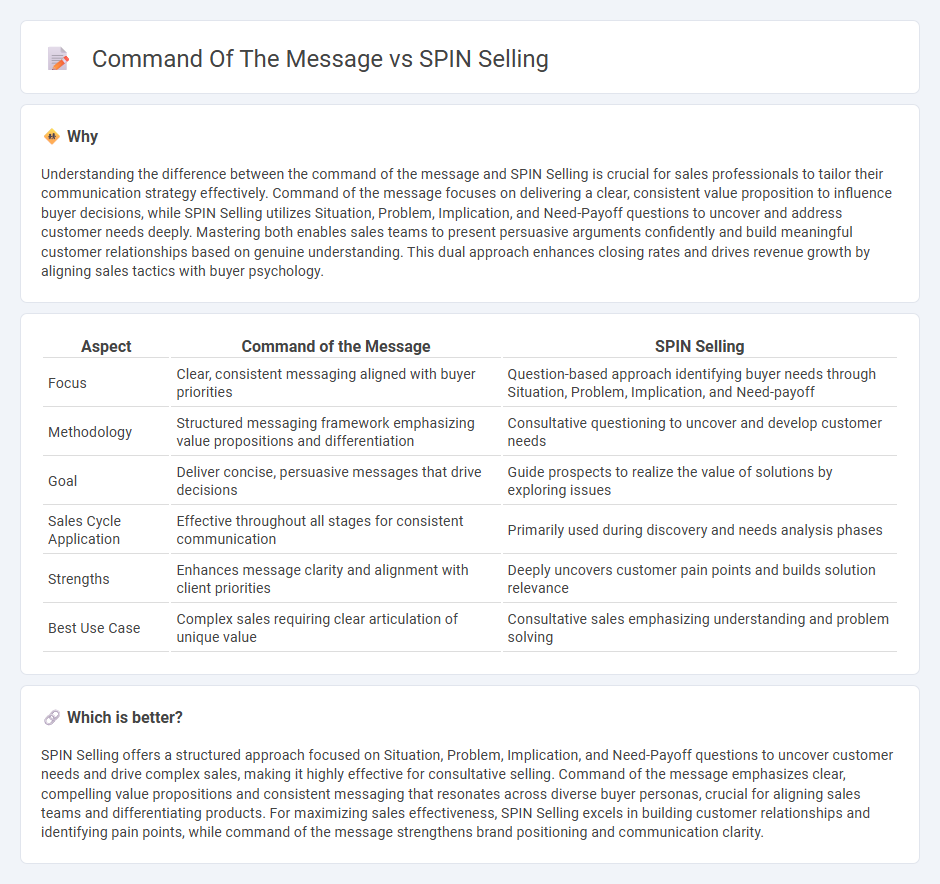
Command of the message focuses on delivering a clear, compelling value proposition that aligns with customer needs and decision criteria, driving faster sales cycles and higher conversion rates. SPIN Selling emphasizes understanding customer situations, problems, implications, and needs-payoff through strategic questioning to build deeper relationships and tailored solutions. Explore how mastering these approaches can transform your sales effectiveness and customer engagement.
Why it is important
Understanding the difference between the command of the message and SPIN Selling is crucial for sales professionals to tailor their communication strategy effectively. Command of the message focuses on delivering a clear, consistent value proposition to influence buyer decisions, while SPIN Selling utilizes Situation, Problem, Implication, and Need-Payoff questions to uncover and address customer needs deeply. Mastering both enables sales teams to present persuasive arguments confidently and build meaningful customer relationships based on genuine understanding. This dual approach enhances closing rates and drives revenue growth by aligning sales tactics with buyer psychology.
Comparison Table
| Aspect | Command of the Message | SPIN Selling |
|---|---|---|
| Focus | Clear, consistent messaging aligned with buyer priorities | Question-based approach identifying buyer needs through Situation, Problem, Implication, and Need-payoff |
| Methodology | Structured messaging framework emphasizing value propositions and differentiation | Consultative questioning to uncover and develop customer needs |
| Goal | Deliver concise, persuasive messages that drive decisions | Guide prospects to realize the value of solutions by exploring issues |
| Sales Cycle Application | Effective throughout all stages for consistent communication | Primarily used during discovery and needs analysis phases |
| Strengths | Enhances message clarity and alignment with client priorities | Deeply uncovers customer pain points and builds solution relevance |
| Best Use Case | Complex sales requiring clear articulation of unique value | Consultative sales emphasizing understanding and problem solving |
Which is better?
SPIN Selling offers a structured approach focused on Situation, Problem, Implication, and Need-Payoff questions to uncover customer needs and drive complex sales, making it highly effective for consultative selling. Command of the message emphasizes clear, compelling value propositions and consistent messaging that resonates across diverse buyer personas, crucial for aligning sales teams and differentiating products. For maximizing sales effectiveness, SPIN Selling excels in building customer relationships and identifying pain points, while command of the message strengthens brand positioning and communication clarity.
Connection
Mastering the message in sales involves clearly understanding and communicating the customer's needs, a principle central to SPIN Selling which focuses on Situation, Problem, Implication, and Need-Payoff questions. Commanding the message ensures that sales professionals effectively guide conversations through SPIN Selling's framework, uncovering deeper pain points and aligning solutions accordingly. This strategic control of dialogue enhances value perception and drives successful sales outcomes by addressing client priorities with precision.
Key Terms
Situation Questions (SPIN Selling)
Situation Questions in SPIN Selling aim to gather essential background information about the customer's current circumstances to tailor solutions effectively. Unlike Command of the Message, which emphasizes messaging clarity and value articulation, Situation Questions focus on understanding context before proposing solutions. Explore deeper insights into how these methods enhance sales strategies by learning more here.
Critical Issue (Command of the Message)
SPIN Selling emphasizes identifying and exploring customer needs through Situation, Problem, Implication, and Need-Payoff questions to drive sales success. Command of the Message prioritizes addressing the Critical Issue by clearly articulating the core value proposition and aligning messaging with the buyer's top challenge. Discover how mastering the Command of the Message can transform your sales approach by focusing tightly on what truly matters to your customers.
Impact (Command of the Message)
Command of the Message emphasizes creating a clear, compelling value proposition that resonates deeply with buyers' specific business challenges, driving impactful conversations that lead to decisions. SPIN Selling focuses on uncovering customer needs through Situation, Problem, Implication, and Need-Payoff questions but can lack the strategic alignment that Command of the Message delivers to influence buying behavior. Discover how mastering Command of the Message can transform your sales impact and close more high-value deals.
Source and External Links
What is the SPIN Sales Methodology? - Sales Enablement Collective - SPIN Selling is a research-based sales process created by Neil Rackham that guides sales reps to ask four types of questions (Situation, Problem, Implication, Need payoff) to uncover prospects' needs and build trust, especially effective for complex B2B sales.
SPIN selling: A comprehensive guide on how it works - Zendesk - SPIN Selling consists of four stages: Opening, Investigating, Demonstrating capability, and Obtaining commitment, focusing on building sincere relationships and gathering in-depth information through strategic questioning without rushing to the product pitch.
The SPIN Selling Method -- I Took a Deep Dive so You Don't Have to - HubSpot - The acronym SPIN stands for Situation, Problem, Implication, and Need-Payoff questions that salespeople ask in a strategic sequence to deeply understand buyer challenges and to guide them toward realizing the value of the offered solution.
 dowidth.com
dowidth.com